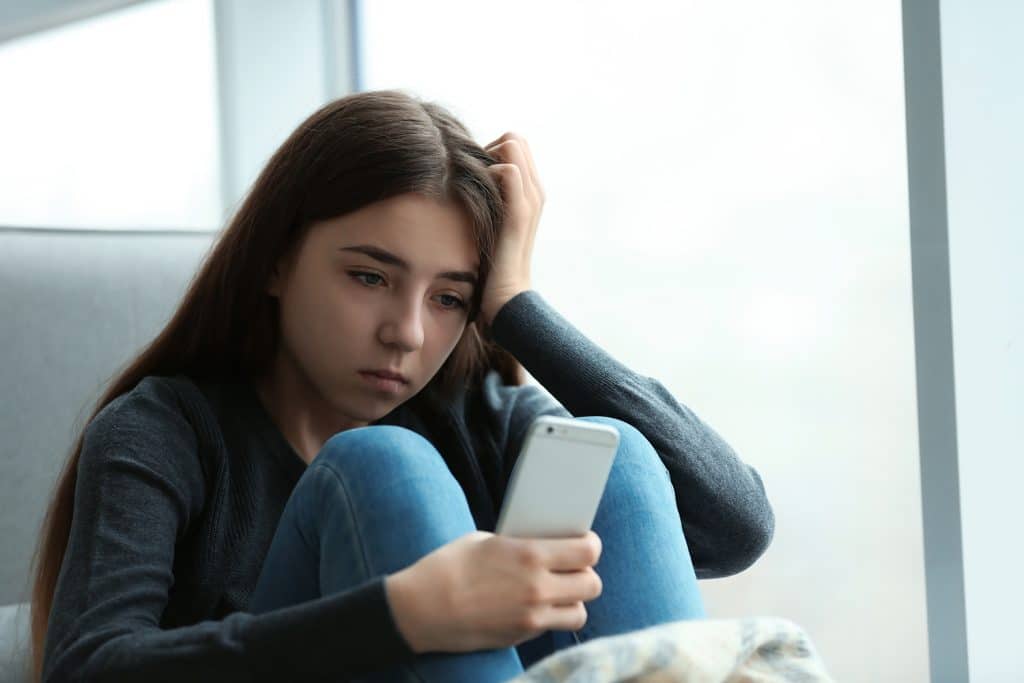Does Social Media Cause Teen Depression?
Identifying and addressing the influence of social media
DEC 01, 2021
Does Social Media Cause Teen Depression?
Identifying and addressing the influence of social media
Teens at Risk for Depression
Adolescence can be compared to a roller coaster, with dizzying twists and turns. Beyond the range of expected mood swings, a significant number of teens experience concerning mental health crises. The National Institute of Mental Health shares that “[a]n estimated 3.2 million adolescents aged 12 to 17 in the United States had at least one major depressive episode. This number represented 13.3% of the U.S. population aged 12 to 17” (National Institute of Mental Health, 2017). Recognizing the ways depression manifests and identifying environmental factors that worsen teens’ quality of life will empower parents to provide their children with needed support.
Signs of Teen Depression
Family members and educators are in a prime position to notice concerning behavior in the children close to them. Educating oneself about the signs is crucial to intervene and offer help. The Centers for Disease Control has published a list of common symptoms amongst those experiencing these persistent lows. A family physician should always be consulted if there are any suspicions of depression because they can provide tools and resources to help.
Examples of behaviors often seen in children with depression:
- Feeling consistently sad, hopeless, or irritable
- Wanting to avoid fun things
- Changing food patterns—eating a lot more or a lot less than usual
- Mixing sleep patterns—sleeping a lot more or a lot less than normal
- Moving less or energy changes—being more tired, sluggish, tense or restless than is typical
- Having a hard time paying attention
- Feeling worthless, useless, or guilty
- Showing self-injury and self-destructive behavior
Social Media & Depression
Depressive disorders are often triggered by factors outside the control of both children and parents. However, one factor has recently emerged. Screen time, particularly time spent on social media, is suspected of creating and exacerbating symptoms of depression. Researchers concluded that in girls ages 13-15, greater use of social media is associated with self-harm, depression, and lower self-esteem (Barthorpe, 2020). Knowing that one-third of surveyed adolescents have trouble controlling their social media use, clinicians and parents can identify a destructive cyclical pattern. Researchers in the UK showed that symptoms of depression in females doubled with every additional 30 minutes spent exposed to social media (Dempsey, 2020).
Time spent on social media has been shown to both create and exacerbate symptoms of depression.
—Amber Barthorpe, South London & Maudsley NHS Foundation Trust, UK
The Stress of Maintaining an Online Persona

Users of social media construct a persona they present to their followers. Selfies are abundant and carefully chosen to convey an ideal life. The practice of portraying one’s life through selfies allows users to curate a view of their lives, edited. These self-portraits allow individuals to capture their image and present their lived experiences in the most flattering ways (Stokes, 2017, p.160). Filters and editing tools create further distance between one’s posed self and one’s authentic self (p. 161). These offerings are up for consumption and judgment, with instant notifications sounding the bells of social proof—the lack of response silently signaling social deficit. Teenagers who constantly measure their own lives against those in their network soon develop anxiety and depression (p. 161). Actually, despite the desire for attention and acceptance being developmentally normal in adolescence, it can be unhealthy if you feed it in infinite amounts.
Using a Family Media Plan to Create Safe Spaces
Involve the whole family
Establishing screen time limits can mediate the negative effects social media exposure can trigger. A family media plan is a team approach that helps suffering children. Creating a plan from scratch may feel intimidating, especially if screen time has not been restricted in the past. We’ve found the following resources to be very helpful:
Including children as stakeholders in creating the plan may increase children’s buy-in. When discussing limits for technology, an active parent-child discussion on the topic did the most to reduce negative media influence on children. When given a voice, young people are more prone to safe technology use (Dempsey, 2020).
It will be beneficial to make your plan clear and enforceable. You can set boundaries by utilizing parental controls on your home network and your child’s phone. Better yet, provide them with a safe device without the internet. Show a personal willingness to engage in family time by setting limits for yourself and sharing your progress with your child. When you approach these changes as a team and celebrate the small victories together, you will bond over the shared experience of living beyond the screen.
Give them the facts
Ongoing conversations about healthy tech habits are easier when parents are informed about the risks and side effects of exposure to social media. Openly sharing concerns creates a safe, trusting environment. When you gather together, let your children know what you have noticed about their phone use. Many kids don’t realize just how dependent they are on their devices. Ask how being on social media makes them feel. Explain the risks and the results of unchecked scrolling, focusing on what you truly want for them. Educating your children about the costs and benefits will equip them with tools to minimize the risk of depression.
Fill the void
While your family is making a transition to less time on devices, your teen may experience feelings of loss. Even though they have been caught in a negative loop, the compulsive behaviors that attend heavy usage will not disappear overnight. The desire to check in on others, post a status, and wait for ‘likes’ will still be there. Consider filling the void with purposeful alternatives. Lead by leaving phones behind and engaging with your family in ways that make sense for your situation. Any time spent together will make a positive impact. You’ll have more opportunities to talk and gain insight into your child’s experience.
Coping With Depression
While reducing social media exposure may reduce symptoms, keep in mind that the disorder may still exist even if you eliminate the trigger. There is no one-size-fits-all solution to depression, according to the National Institute of Mental Health (NIMH). Finding the right treatment may take some trial and error” (U.S. Department of Health, n.d.).
The NIMH suggests the following approaches as coping strategies but still emphasizes consulting a physician.
Coping Strategies for Depression:
- Be active and exercise.
- Set realistic goals for yourself.
- Spend time with others and confide in trusted friends or relatives.
- Avoid isolating yourself, and let others help you.
- Expect your mood to improve gradually, not immediately.
- Postpone important decisions like marriage, divorce or changing jobs until you feel better. Discuss important decisions with others for objectivity.
- Continue to educate yourself about depression.
National Institute of Mental Health, 2018
Watching your child struggle with depression is painful. Knowing you are helping them build resilience will give you hope. You are part of a strong community of parents who are willing to have tough conversations and make changes so that kids can thrive.












Success!
Your comment has been submitted for review! We will notify you when it has been approved and posted!
Thank you!